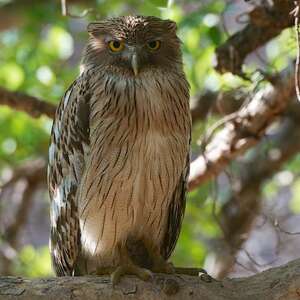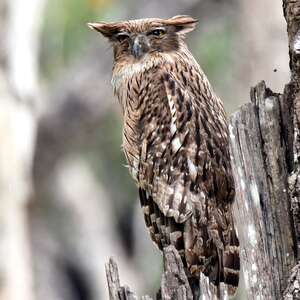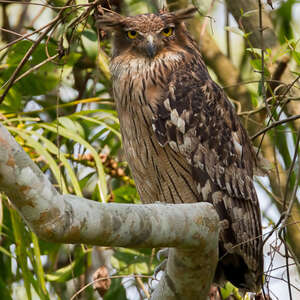Brown Fish Owl
Ketupa zeylonensis - Kétoupa brun
Identification
Ketupa zeylonensis, an enigmatical latin name, does Kétoupa come from indian mythology, where Ketu corresponds to the lunar descending phase? One thing is certain, our nocturnal raptor claims ceylonese belonging, zeylonensis coming from botanical latin, meaning the ceylonese origin. Ketupa zeylonensis can also be called Bubo zeylonensis, genetic analyses showing big similarities with the Bubo gene. Brown Fish Owl measures from 50 to 57 cm, the tufts of ears are generally worn horizontally and give a nearly flat head to our raptor, the big yellow ocular circles surround the black pupils, the eyes are slightly circled with grey, the cheeks being light brown. The bill is greyish white and visibly strong. The forehead and the skullcap are light brown, sometimes darker on some individuals, and clearly striped with nearly black vertical browns, the throat is off-white, we remark it especially when the bird straightens the head; the plumage of all chest and belly is cream. When we observe attentively the bird, we remark very light horizontal grey undulations on the chest and belly, and then thin dark brown marks complete the very worked dress of the Brown Fish Owl, granting him an haughty and noble port. The nape, the mantle and the back are brown, also striped with darker stripes and much broader than those observed on the belly. The brown-orange scapulars are speckled with a very dark brown color and are mottled with small off-white points, the same marking is visible on all coverings with spots and small light brown points appearing. These light brown points become more visible on the middle-sized and big coverings; the remiges will then take the same dark brown color, on the borderline of black, which speckled the scapulars and those bigger light brown points become then horizontal stripes.The tail, not very visible, is always a dark to blackish brown colour, striped with wide white to cream markings. The yellow legs have bare tarsi, which will probably help the bird when it is in the water. Females are slightly larger than males, juveniles are much less spotted and the various stripes are less pronounced.
Subspecific information 4 subspecies
- Ketupa zeylonensis zeylonensis (Sri Lanka)
- Ketupa zeylonensis semenowi (se Turkey, Middle East to nw India)
- Ketupa zeylonensis leschenaulti (India through Myanmar to w Thailand)
- Ketupa zeylonensis orientalis (ne Myanmar to se China, Indochina and the Malay Pen.)
Foreign names
- Kétoupa brun,
- Búho pescador de Ceilán,
- bufo-pescador-castanho,
- Fischuhu,
- indiai halászbagoly,
- Bruine Visuil,
- Gufo pescatore bruno,
- brun fiskuv,
- Brunfiskeugle,
- ketupa rybárka,
- ketupa rybí,
- Brun Fiskeugle,
- kalahuuhkaja,
- duc pescador bru,
- Árugla,
- ketupa bosonoga,
- brūnais zivjūpis,
- ribja uharica,
- Бурый рыбный филин,
- ミナミシマフクロウ,
- 褐渔鸮,
- นกทึดทือพันธุ์เหนือ,
- 褐漁鴞,
Voice song and call
Habitat
Behaviour character trait
Dietfeeding habits
The Anglo-Saxons call it the Brown Fish Owl, literally the brown fishing owl, so we have a nocturnal raptor specialized in its diet which includes various fish, crustaceans, amphibians, all living in aquatic habitats.
It will vary its menu with rodents, reptiles or other birds, and may become a scavenger on occasions. This hunter is, of course, nocturnal, but it can be seen hunting at dusk. It usually stays perched, on the lookout, ready to dive, and can then be observed standing in the middle of a river, with its prey in its claws.Reproduction nesting
The Brown Fish Owl has a breeding period from November to May in India, and typically during April in Sri Lanka.
The bird prefers dry seasons as it will be easier to fish. It is thought that the Brown Fish Owl is an example of fidelity as the pair will be bonded for life, nesting in the hollow of a large tree or a large cliff crevice as long that it's near a water source. Pairs have also been observed nesting in abandoned dwellings. Generally, 2 to 4 eggs will be incubated by the female for 34 to 38 days, and the chicks will leave the nest after 50 days.Geographic range
The subspecies Zeylonensis gives its name to the species in Sri Lanka. It has been observed in India, Myanmar and Thailand with the subspecies Leschenault which is larger and of a general lighter brown shade; the subspecies Orientalis, much darker, almost black on the head, is found east of Thailand all through the Indochinese peninsula and China. Lastly, the subspecies Semenowi with redder plumage is found south of Turkey, in northern Syria and in northwest India; the Brown Fish Owl was observed in Israel in the 1970s, but has probably since disappeared.
Threats - protection
IUCN conservation status
concern
in the Wild
threatened
evaluated
Overall, the Brown Fish Owl is not endangered, but the perception can differ drastically depending on the location... In Sri Lanka, it is considered one of the most common Strigidae! Its presence is strong in India and Eastern Indian Peninsula, Indochina and China. On the other hand, the situation is completely different from Pakistan and to the west of the country. In Turkey, it is one of the mythical raptors that few people have observed, in Israel, it has disappeared victim of pesticides and the disappearance of many marshes. The same goes for Syria, Iraq and Iran, where, for various reasons, man does not make much of nature. It is up to us to be vigilant so that we can continue to observe one of the most beautiful nocturnal raptors in the world!
Sources of information
- IOC World Bird List (v15.1), Gill, F and D Donsker (Eds). 2025-12-07.
- Vol. 5 - Handbook of the Birds of the World, Josep del Hoyo-Andrew Elliott-Jordi sargatal
- A Field Guide to the Birds of the Indian Subcontinent, Krys Kazmierczak, Ber Van Perlo
- A Photographic GUIDE TO THE BIRDS OF INDIA, Bikran Grewal, Bill Harvey, Otto Pfister
- xeno-canto, Sharing bird sounds from around the world,
- ARKive, Christopher Parsons
- BirdLife International, BirdLife International
- Oriental Bird Club,
- Planet of Birds,
- The Owl Pages, Deane P.Lewis
- Wikipédia, Wikipedia, The Free Encyclopedia
Other sources of interest
 Specification sheet created on
31/07/2023 by Anne et Gabriel Leboff
Specification sheet created on
31/07/2023 by Anne et Gabriel LeboffTranslation by AI Oiseaux.net
© 1996-2026 Oiseaux.net
- Accipitriformes
- Aegotheliformes
- Anseriformes
- Apodiformes
- Apterygiformes
- Bucerotiformes
- Caprimulgiformes
- Cariamiformes
- Casuariiformes
- Charadriiformes
- Ciconiiformes
- Coliiformes
- Columbiformes
- Coraciiformes
- Cuculiformes
- Eurypygiformes
- Falconiformes
- Galliformes
- Gaviiformes
- Gruiformes
- Leptosomiformes
- Mesitornithiformes
- Musophagiformes
- Nyctibiiformes
- Opisthocomiformes
- Otidiformes
- Passeriformes
- Pelecaniformes
- Phaethontiformes
- Phoenicopteriformes
- Piciformes
- Podargiformes
- Podicipediformes
- Procellariiformes
- Psittaciformes
- Pterocliformes
- Rheiformes
- Sphenisciformes
- Steatornithiformes
- Strigiformes
- Struthioniformes
- Suliformes
- Tinamiformes
- Trogoniformes






























